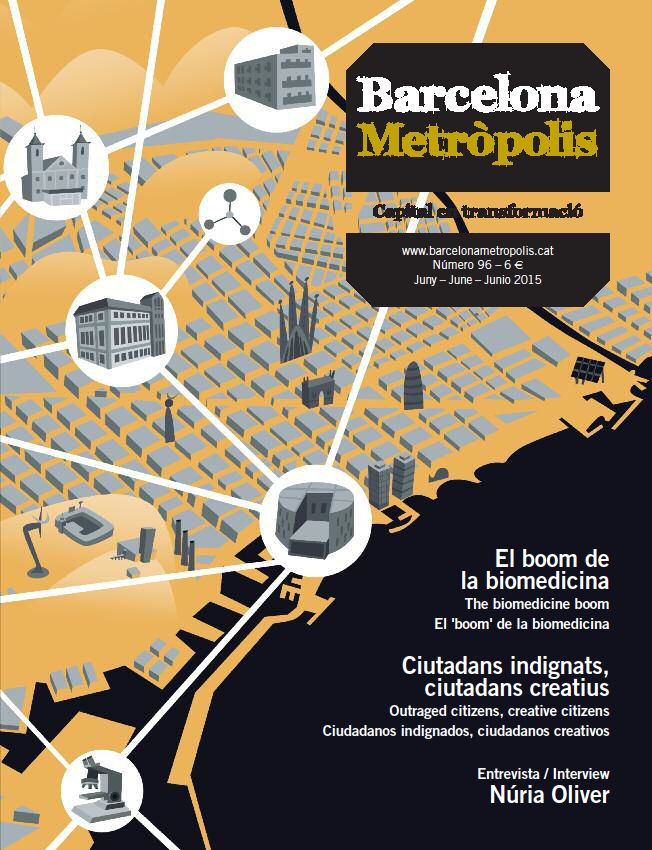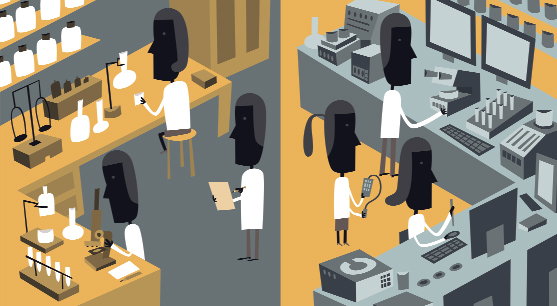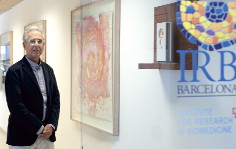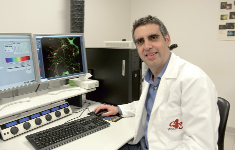Barcelona has established itself as major science hub, and biomedicine is by far its most powerful engine. In just a few years, this highly diversified field has turned the city and its sphere of influence into one of the most appealing career destinations in Europe and beyond.
“We’re playing in the Champions League.” This is the answer a scientist or a qualified manager is most likely to give when asked about the state of biomedicine in Barcelona, and by extension Catalonia. The chances of winning the Cup are low, they might add, but there is no doubt whatsoever that the city’s name appears on the list of Europe’s best. “Barcelona is where it’s happening”, more than one might say, and they would be right. But it hasn’t always been this way, nor was it easy to reach this point.
Winning this championship has nothing to do with luck or chance. It means figuring out how one mutant gene causes a serious illness, examining what factors cause this mutation, discovering a molecule that blocks the action of the defective gene and transforming it into an effective drug. Everyone seems to agree that this process is occurring in and around Barcelona, but the circle is still not nearly as complete as the scientific powerhouses of Cambridge, Oxford, Boston or Stanford, to name a few. These regions bring together preeminent institutions of basic research, hospitals with robust research departments and companies with powerful research and innovation departments in a single hub. Barcelona is not quite there yet, but it is starting to look that way.
For some time now, a firm commitment made at the turn of this century has started to bear fruit, fifteen years on and in a radically different scenario. From having practically nothing in terms of what is referred to as ‘big science’, Barcelona can now claim to have at least a half-dozen institutes and large-scale facilities which can hold their own amongst the best in Europe. If we add the transformation of its referral hospitals into centres that also conduct research, a large part of the picture is complete. All that are missing are companies, as the existing ones are too small to make a sizeable impact internationally. Nevertheless, the city is fast gaining ground on the great scientific capitals.
Fotis Kafatos, the first Secretary General of the European Research Council (ERC), Europe’s top research institution, often said that “talent is the best-distributed resource on the planet”. But the ground must have the right conditions to bear the desired fruit. This is what has been happening in Barcelona over the past few years, where Catalan centres receive more funding from the European authorities in each call for papers and have more elements in place to compete on a level playing field. Young and not-so-young researchers the world over are opting for the Catalan capital just as readily as they might head to Vienna, Paris, Munich or any number of American universities.
Of course, it wasn’t always this way. If these days one can say success in an area of biomedicine is just a hop, skip and a jump away, thirty years ago no one would have been so bold as to make that claim, especially not in Barcelona. At that time, Catalan science, systemically speaking, was insignificant; everything noteworthy took place in Madrid. The most significant and prestigious biochemists, such as Nobel Prize winner Severo Ochoa, plus a tiny group of pioneering researchers the likes of Federico Mayor Zaragoza, Margarita Salas, Eladio Viñuela and Santiago Grisolía, had left their imprint on the first generation of scientists, who went abroad to complete their studies. It was a time when one had to do a postdoctoral fellowship at a prestigious research centre in order to become a tenured professor or member of a university’s department of biochemistry, the main field that fuelled biomedicine.
Hospitals in those times, the eighties, were not the pillars of the modern science system we know now. Only Madrid’s Puerta de Hierro Hospital had a research department. In terms of science, the university system was still entrenched in a highly rigid and clannish system and only the Spanish National Research Council (CSIC), with a delegation in Barcelona, was making a contribution to general knowledge, however minimal. Joan J. Guinovart, the current director of the Institute for Research in Biomedicine (IRB Barcelona) professor at the University of Barcelona, remembers that time being particularly “dismal and grey”, especially in Catalonia, where science would take years to earn its place on the list of priorities. “University biochemistry departments had to overachieve, due to the fact we had to go abroad to complete our studies”, explains Guinovart. “There we came in contact with expert scientists and also learnt how to apply their knowledge when we came back, despite having far fewer resources.”
That is, of course, if they came back at all. Many chose not to, among them Joan Oró, Àngel Pellicer and, a bit later, Joan Massagué. Nevertheless, all would end up having an influence, one way or another, on the emergence of Barcelona as a scientific port of call.
From black to grey
What was happening in the field of biochemistry in the early eighties was not exclusive to Catalonia; it also was occurring in Madrid, where Severo Ochoa’s prestige made it possible to open the first large research site, the Centre for Molecular Biology (CBM). Barcelona tried to match forces, with the Institute for Fundamental Biology (IBF), but it all came to nothing. Only the major hospitals would make a difference, with the Barcelona’s Hospital Clínic leading the way under the influence of Joan Rodés: 3% of doctors’ salaries would go to research, particularly clinical research.
The training of those biochemistry pioneers and the impetus of Hospital Clínic would become the initial ingredients of what was just starting to brew. The great change, however, would come from the Spanish Parliament in 1986 with the first Science Law, that would bring about the Spanish National Evaluation and Foresight Agency (ANEP) and the Spanish National Plan. Quality research projects became top priorities, regardless of where they originated, and there was a minimum amount of funding. Catalonia, however, lacked the money and authorities to champion such a policy. Many in the field at the time were convinced of the absence of political will. There was just one severely underfunded body, the Interdepartmental Commission for Research and Innovation in Technology (CIRIT). Only university departments and CSIC centres managed to distinguish themselves in Catalonia. Favouritism and a lack of resources would doom Joan Oró’s attempts to create a centre of any importance in Barcelona.
Quite a few years would have to pass before things started to change. If science was not a priority in Catalonia, it was no better in Spain. Budgets ran aground under the governments of Felipe González and José María Aznar, and not until the new century dawned did the so-called “Mas- Colell miracle” begin to turn things around. Thanks to this Finance Minister’s policy in support of research centres and the founding of new research organisations – especially the Catalan Institution for Research and Advanced Studies (ICREA), which made it possible to take on researchers with salaries and conditions comparable to those at most international centres – the nucleus of today’s emerging hub began to take shape.
All this resulted in the founding of the Centre for Genomic Regulation (CRG), initially led by Miguel Beato and later by Luis Serrano, which quickly carved a niche for itself in Europe by researching specific aspects in the expression of genes, synthetic biology and systems biology; the IRB Barcelona, headed by Joan J. Guinovart with the help of Joan Massagué, was devoted to basic aspects of molecular biology with biomedical derivations in key areas such as oncology, Alzheimer’s and diabetes; the Institute of Photonic Sciences (ICFO), led by Lluís Tornert, focusing on the study and applications of light; the Barcelona Supercomputing Center (BSC), under the supervision of Mateo Valero, which has produced an essential tool in biomedical research: the supercomputer Mare Nostrum; and the ALBA synchrotron, led by Pere Pascual, the first large-scale facility in Catalan science and one of the most powerful in Southern Europe.
Alongside these large centres, which today compete in the same league as the European leaders, are smaller centres which are no less important and by all means complementary. Fields such as bioengineering, nanotechnology, neuroscience, infectious disease, genome analysis, biocomputing and others that play an important role in the biomedical field have all carved a niche in the Barcelona area, now a major science hub. Hospital research institutes complete the network: IDIBAPS at Hospital Clínic, IDIBELL at Bellvitge Biomedical Research Institute and the Vall d’Hebron Research Institute are the main examples.
There was a time when conversations about scientists in Spain inevitably turned to its cancer specialists: Mariano Barbacid, Manuel Perucho, Àngel Pellicer and later Joan Massagué, who were given the nickname The Four Musketeers of Oncology. All completed their studies at institutions in North America, where they decided to take up residence. In time, some directly and others indirectly, all would have a great influence on Catalonia. These specialists and subsequent generations of equally powerful scientists eventually turned Barcelona into one of the world’s top cancer care and research hubs.
Cancer research, here in Barcelona and elsewhere, is one the great drivers in the research world. This is in large part explained by the decision of the United States to attempt to eradicate the disease in under a decade, back in the early seventies. Never before had so much funding been invested or had both the private sector and the government gotten involved on such a large scale in a fight against one particular disease. It had been estimated that at least one out of every three people would suffer from cancer at some point in their lives.
The American-led push echoed across the globe. The United States began to attract young researchers from all over the world, who in exchange received all the help they needed to develop their talents. Among them were the Four Musketeers and others who would later form part of the Catalan system.
The most celebrated (with the exception of Joan Massagué) is Josep Baselga, the Physician-in-Chief and Chief Medical Officer of Memorial Sloan Kettering Cancer Center in New York, who was also an adjunct director of the IRB Barcelona for a time and previously the Head of Oncology at Vall d’Hebron Hospital. His arrival at the Barcelona hospital led to a veritable revolution due to his familiarity with the disease and his interest in developing new molecules and improving cancer therapies. His know-how left a deep imprint on the entire hospital, and in some way, other referral centres. The baton was passed to Manel Esteller at the Catalan Institute of Oncology (ICO), which has given a major boost to epigenetic studies, a rapidly expanding field.
The momentum of cancer research and its translation to clinical practice coincide with the effective transformation of Catalan hospitals into knowledge centres, which requires an implicit connection with places that do basic science and the application of new approaches in the clinical research of multiple diseases. Barcelona has taken part in great advances in cardiology, neuroscience and infectious diseases, not to mention its extremely important role in organ transplants and its growing presence in the study of rare diseases.







